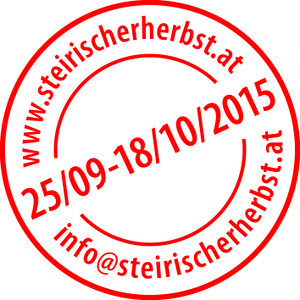September 26, 2015–January 11, 2016
Sackstraße 18
8010 Graz
Austria
Curated by Tessa Giblin
Earth is riddled with signals that terrestrial timekeepers use to tell the story of our planet while they carve up geological history. Whether rigorously evidenced or fantastically envisioned, change is upon us. The climate has changed, the epoch has arguably changed, and our relationship to time has changed. Hall of Half-Life is positioned within a dramatic arc of geological history. Its protagonists are stories and objects that resonate well beyond our human life spans and hereditary generations, arching into the deep past, while attempting to envision the signals, languages, monuments or leftovers that might still retain their communicative potential into the deep future.
Within the mountain caves behind the GrazMuseum, Mikhail Karikis* has given a new voice to the impenetrable sounds of the earth, creating a site-specific sound installation within the Schloßberg tunnels. An installation by Lonnie van Brummelen & Siebren de Haan* transports us to the Amazonian forests of Surinam, seating us upon a replica of the artistic and material labour of a culture who’s historical knowledge thereby passes from community into object. In the photographs of Simon Boudvin, we encounter the unknowable belly of the underneath, and in the conceptual work of Lara Almarcegui*, we come to understand that same underneath as a place of material colonialism, where mineral rights either can or cannot be purchased. Peter Galison & Robb Moss* present their first film installation, in the form of a monumental and moving study of nuclear waste containment and radioactive fallout, while the photographic collages of Regina de Miguel propel the questions of Galison & Moss’ research, asking what kind of monuments, markers, objects or ideas will be able to communicate into the deep chasm of the future. The sculptures of Jean-Luc Moulène propose unlikely candidates for that honour, taking us on a conceptual journey through material and representative forms. The landscape of Graz is again evoked within the slowly eroding environment of a new site-specific work by Stéphane Béna Hanly*, while Harun Farocki’s film takes us on a moving journey through world memorials, and our human relationship to them. In a work that also branches out into the Styrian countryside, Mikala Dwyer* creates a networked community of objects and devices, synchronized in a stone-age fashion as conduits of messages between asylum-seeking migrants and the monumentalised industrial ruins of nearby Vordernberg. Complications around representation in general, and the mediation of “bog bodies” in particular, are exposed in a large-scale installation by Sam Keogh*, while Geoffrey Farmer* makes a declaration, and stakes a beginning at the end of the show.
Beyond the exhibition Hall of Half-Life, and the catalogue designed by Åbäke and published by Dent-de-Leone which includes texts on the artists and essays by Peter Galison and Tessa Giblin, are two further, special commissions of steirischer herbst 2015:
Gerard Byrne* is developing a new work that will be presented within, and riffing against, the extraordinary display system of the permanent collection of the GrazMuseum, while Ulla von Brandenburg* launches a major new work in the nearby town of Leoben. Amalgamating the sites of theatre, exhibition-making and cinema, von Brandenburg is developing a structure, artwork, platform and environment that stitches together many of the multi-disciplinary energies within the steirischer herbst festival at large.
* newly commissioned work for steirischer herbst
With its leitmotif Back to the Future, steirischer herbst 2015 focuses in many different ways on the notion of “inheritance,” during a four-week-long festival which brings cutting edge contemporary performance, theatre, dance and music to Graz, Austria. steirischer herbst festival works with a network of international visual arts curators, who have included in recent years WHW, Luigi Fassi, Katerina Gregos, Stefano Colicelli and in 2015 Tessa Giblin, Curator of Project Arts Centre, Dublin. Additionally, co-operation projects with various art institutions of Graz are completing the visual arts programm of the festival—all opening on the weekend of 26–27 September.
For media information: presse [at] steirischerherbst.at
For catalogue and exhibition enquiries: pelzmann [at] steirischerherbst.at
For more information on the festival and the complete programme please visit: www.steirischerherbst.at



